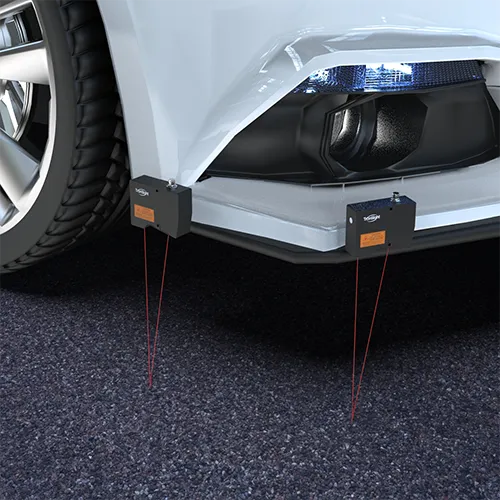AUTO03.High-Speed Road Flatness Measurement for Safer Roads
Sep 08, 2025
1. What is Road Surface Flatness and Why It Matters
Road surface flatness, sometimes referred to as road roughness or pavement evenness, describes the degree of smoothness of a road surface along its longitudinal profile. It is one of the most critical indicators for evaluating pavement quality and directly impacts safety, driving comfort, and long-term maintenance costs.
A flat road surface ensures that vehicles maintain stable contact with the pavement, reducing vibrations, tire wear, and the risk of accidents. Conversely, uneven road surfaces increase rolling resistance, fuel consumption, and repair frequency.
In civil engineering and transportation, flatness measurement is widely applied in:
-
Highways and expressways – ensuring compliance with ride quality standards.
-
Airport runways – guaranteeing safe aircraft takeoff and landing.
-
Urban infrastructure – improving noise control and ride comfort.
-
Bridge decks and tunnels – verifying construction quality and long-term durability.
Internationally, flatness is commonly evaluated by the International Roughness Index (IRI), measured in meters per kilometer (m/km). Many standards such as ASTM E1926 and European EN 13036-12 specify methods for measuring and evaluating road roughness.
Ensuring accurate and efficient flatness measurement is not just a matter of compliance but also a cornerstone of sustainable transportation development.
2. Common Road Flatness Measurement Methods
Several techniques are commonly used in road surface evaluation. Below is a comparative table summarizing the advantages and limitations of each method:
| Method | Principle | Advantages | Limitations |
|---|---|---|---|
| Manual straightedge measurement | A ruler or bar is placed on the road surface, deviations are measured manually | Simple, low cost | Low efficiency, poor repeatability, subjective results |
| Inertial profiler | Measures vehicle movement response with accelerometers and gyroscopes | Widely used, continuous measurement | Accuracy depends on speed and calibration, limited for very fine measurement |
| Contact-type displacement sensor | Mechanical probe follows the road contour | Direct measurement, intuitive | Slow speed, prone to wear, not suitable for long-distance measurement |
| Laser triangulation displacement sensor | Uses laser triangulation to measure road profile non-contact | High precision, high speed, non-contact, real-time data | Requires stable optical conditions, cost higher than manual methods |
From the comparison, it is evident that laser triangulation sensors offer the best balance between accuracy, speed, and automation, making them the preferred choice for modern road surface flatness monitoring systems.
3. Principle and Process of Laser Triangulation Measurement
Laser triangulation displacement sensors operate on a simple yet powerful optical principle. A laser beam is projected onto the road surface, forming a small spot. The reflected light is collected by a lens and imaged onto a CMOS/PSD detector. Based on the displacement of the light spot on the detector, the system calculates the exact distance to the surface using triangulation geometry.
Key features of the measurement process:
-
High sampling rate: With up to 160 kHz sampling frequency, road surface data can be captured even at high vehicle speeds.
-
High linear accuracy: ±0.02% of full scale ensures consistent measurement results across wide ranges.
-
Micron-level repeatability: As fine as 0.02 μm, suitable for detecting minute variations in flatness.
-
Non-contact operation: No risk of wear, no interference with the pavement, and capable of long-term deployment.
When integrated into road profiling vehicles or stationary inspection rigs, laser triangulation displacement sensors continuously scan the pavement, producing detailed surface maps. These data can then be processed to calculate IRI values, identify localized defects, and verify compliance with engineering specifications.
4. Tronsight’s Solution for Road Flatness Measurement
Tronsight provides an advanced solution for road surface monitoring with its TS-P series laser triangulation displacement sensors.
Highlights of the TS-P series:
-
Wide measurement range: 2–2000 mm, suitable for various pavement conditions.
-
Ultra-high speed: Up to 160 kHz sampling rate, enabling real-time flatness measurement even at highway speeds.
-
High precision: ±0.02% of F.S. linear accuracy with 0.02 μm repeatability.
-
Built-in controller: Simplifies system integration and reduces equipment footprint.
-
Customization options: Adjustable line width, light source, wavelength, and structural dimensions for application-specific needs.
Application Scenarios:
-
Highway construction quality assurance – validating pavement smoothness before road opening.
-
Airport runway monitoring – ensuring safe landing conditions for aircraft.
-
Bridge and tunnel inspections – detecting unevenness in confined or critical structures.
-
Long-term pavement maintenance – integrating with intelligent transport systems for predictive maintenance.
By combining high-speed sampling with robust optical design, Tronsight’s TS-P series ensures reliable results under challenging outdoor conditions. Its ability to deliver real-time, high-precision measurements helps engineers and transportation authorities make informed decisions, reduce maintenance costs, and extend road service life.
5. Product Recommendation & Expert Consultation
For road surface flatness measurement applications, Tronsight TS-P series laser triangulation displacement sensors provide a proven, high-performance solution.
👉 Explore the TS-P Series: Leave a message to consult our experts and find the best configuration for your project.
Recent Posts

October 26, 2016
The Most Successful Engineering Contractor








